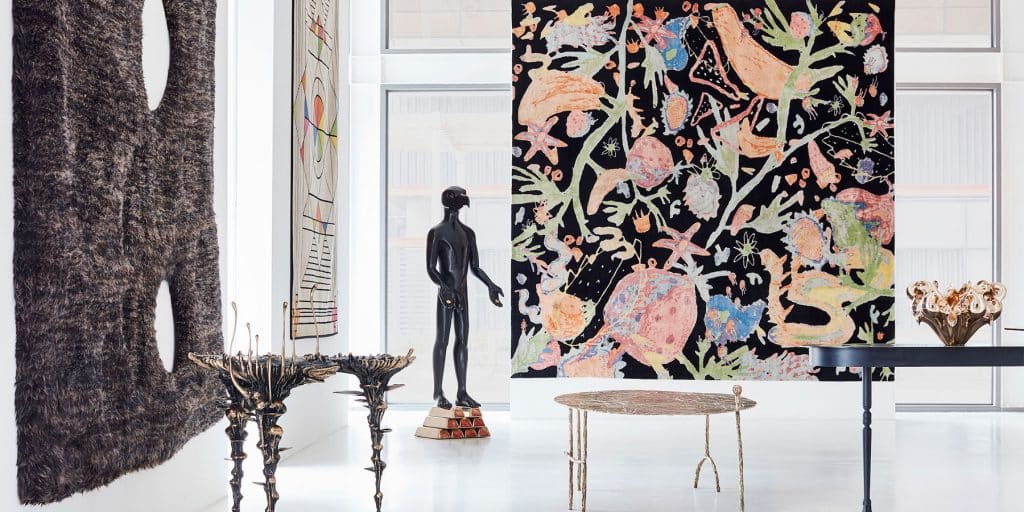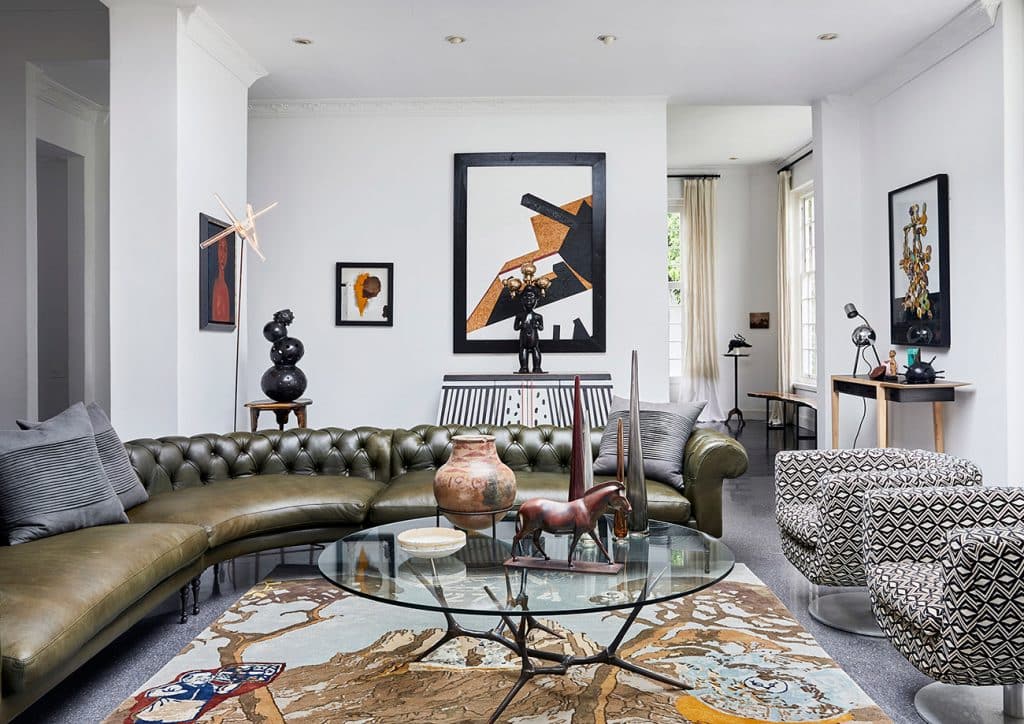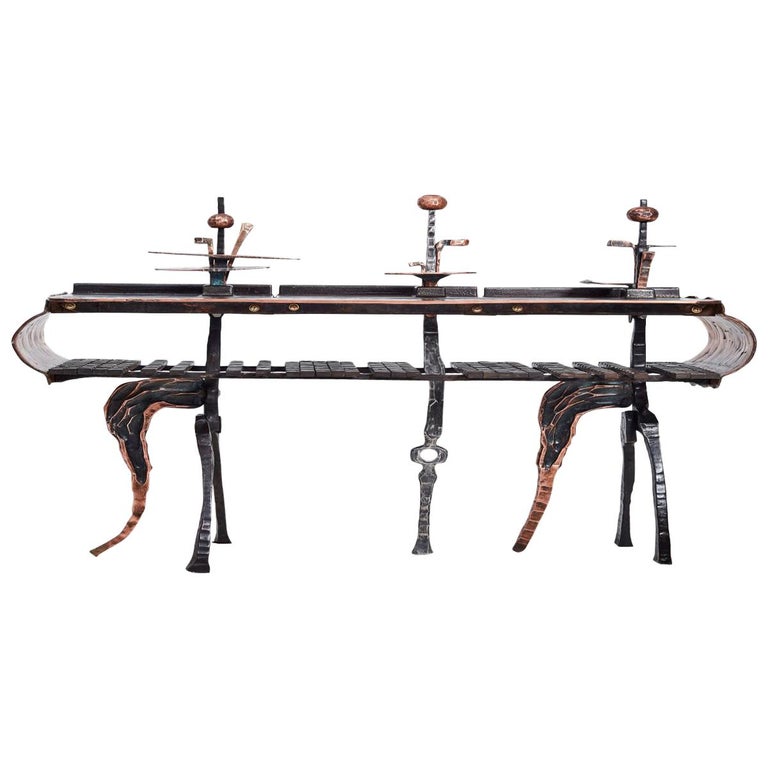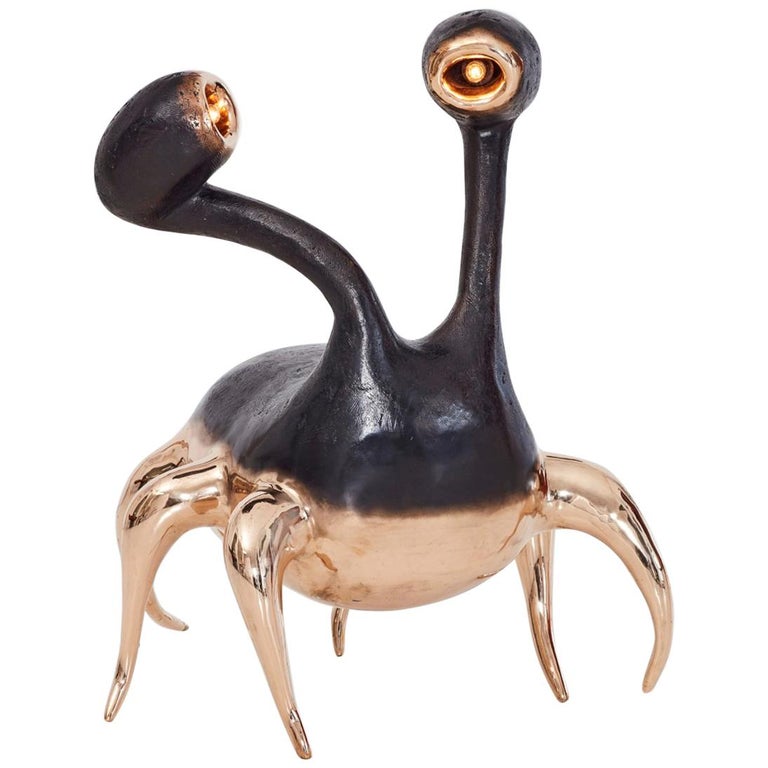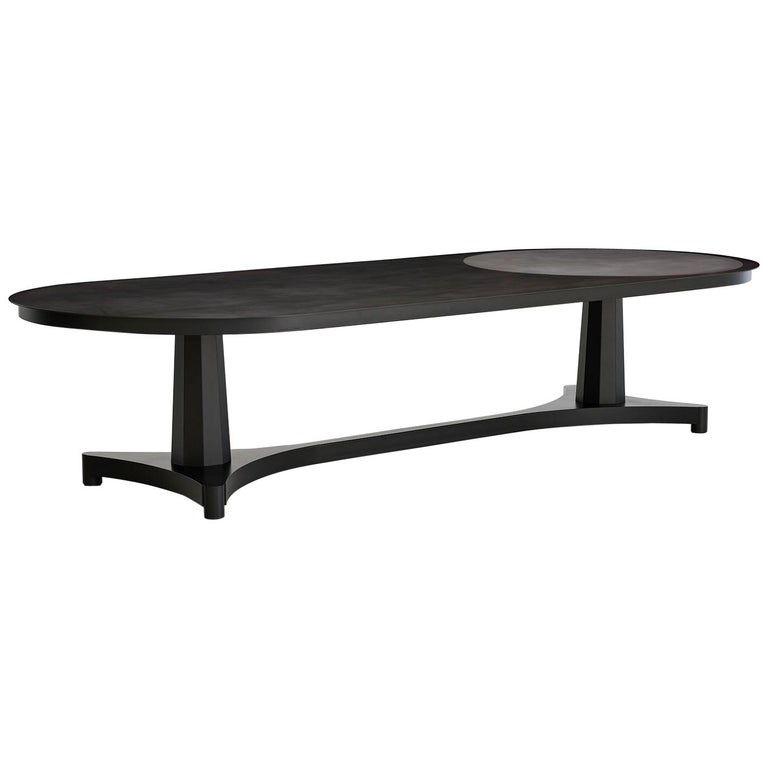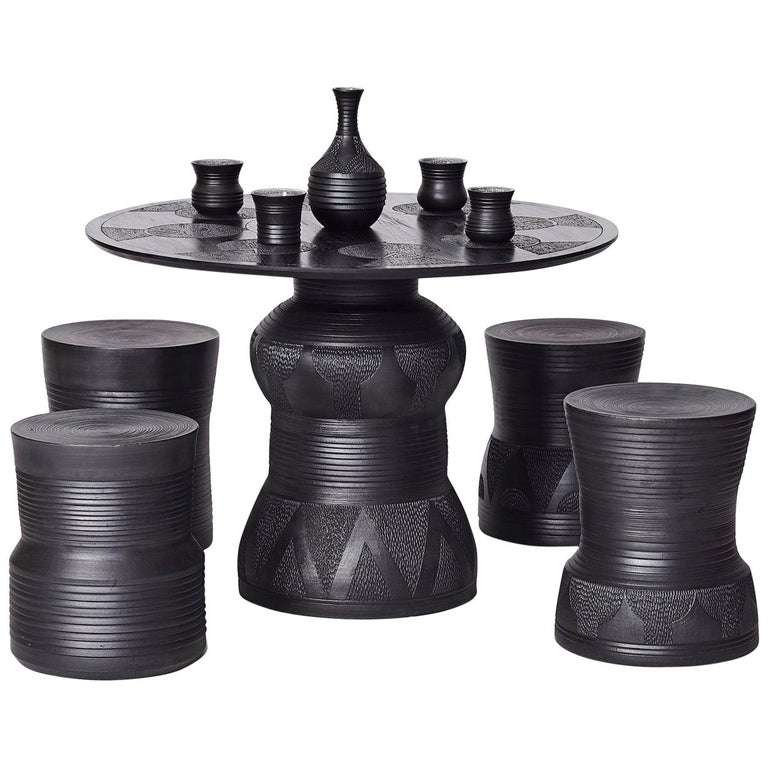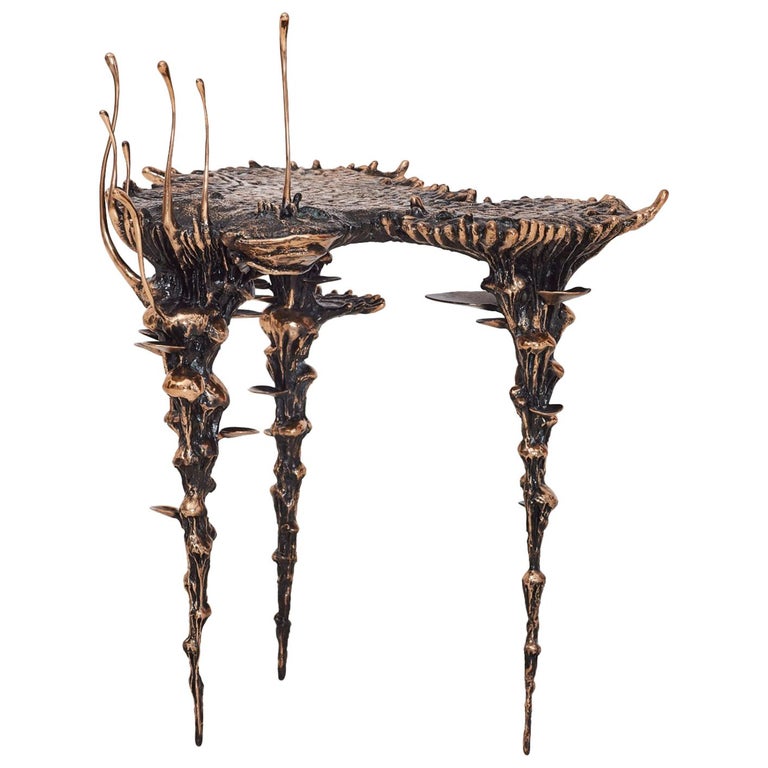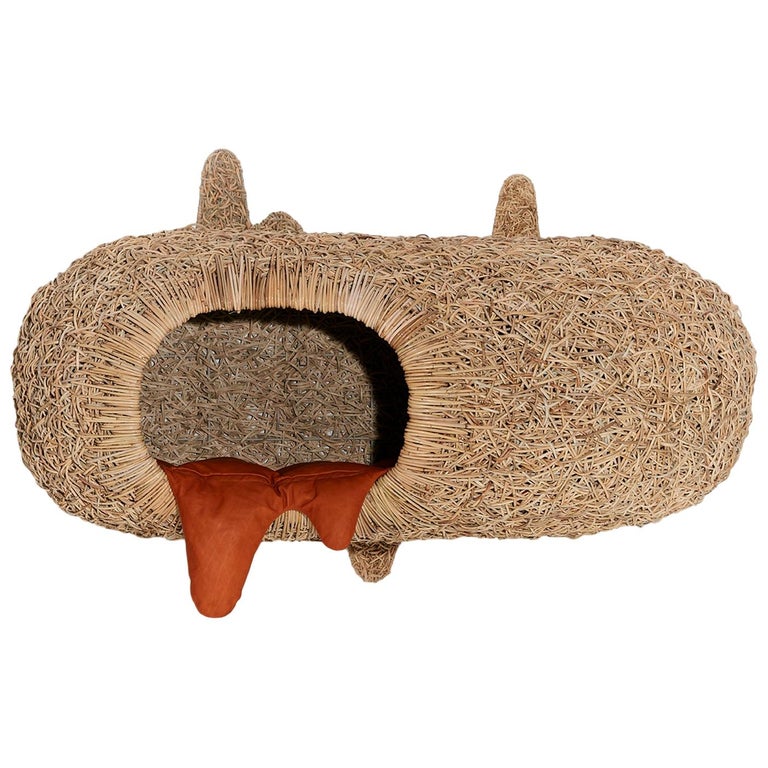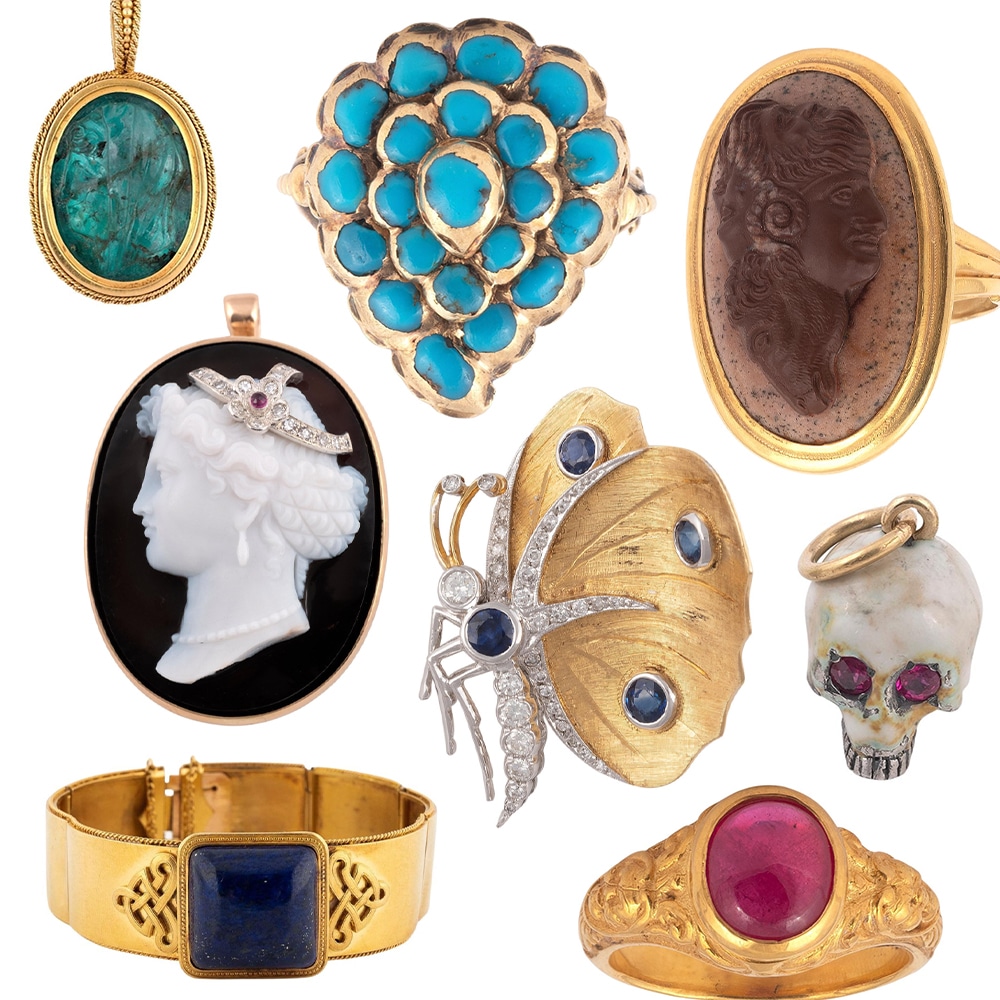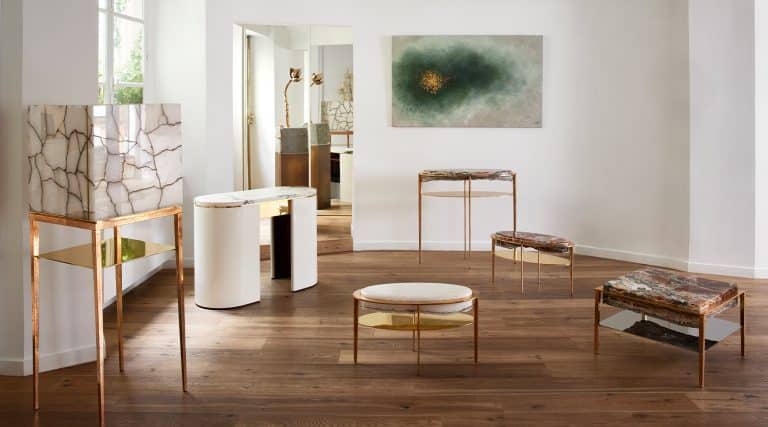July 28, 2019In 2003, Trevyn McGowan, her set designer husband, Julian, and their two children (they now have six) set off from London for a quiet beach holiday in her native South Africa. Formerly an actress, McGowan had for several years been running a small renovation and design business, managing residential building projects. She’d weigh in on interior decoration and help find furniture, often sourcing pieces from South African producers. Feeling a bit burned out by work, she headed with her family to the small, beautiful — and aptly named — town of Wilderness, on the Garden Route along the country’s south coast. “Somehow,” she says, “we ended up buying a house.” Two years later, they moved there permanently, intending to enjoy “a quiet existence” and slow down the pace of their lives.

Julian and Trevyn McGowan’s Cape Town–based gallery, Southern Guild, focuses on contemporary design from South Africa. They’re seen here on a bench by Wiid Design under a Haywire black-ash chandelier by David Krynauw. Behind them, from left, are Andile Dyalvane’s Idladla, Porky Hefer‘s Behd nest, Chuma Maweni’s Imbizo dining table, Justine Mahoney’s Initiation (Special Edition) and Porky Hefer’s M.Heloise hanging seat. To their left are Atang Tshikare’s Ngwana and Ngwedi ceramic tables. Top: Rugs by Rogan Gregory, Renate Müller and Katie Stout frame, from left, Stanislaw Trzebinski’s Extra Terrestrial table, Conrad Botes’s Naked Communist, Misha Kahn‘s extra-large coffee table, Gregor Jenkin’s long sofa table and Astrid Dahl’s Campanula Flower (small). The rugs are part of the Woven Forms collection from the New York galley R & Company, with which the McGowans often collaborate. All photos by Hayden Phipps, courtesy of Southern Guild, unless otherwise noted.
Today, the McGowans run Cape Town’s Southern Guild, a gallery of contemporary South African collectible design with a stellar international reputation. They’ve cultivated this by consistently showing their artists at international fairs, frequently playing a highly active role in shaping their work, as well. They also oversee the nonprofit Design Foundation, which offers financial awards and mentoring to young designers.
What happened to those plans for a quiet life?

Wendell Castle‘s Rain Flower rug, also from R & Company’s Woven Forms, is mounted behind Jesse Ede’s Orbit chandelier and Heino Schmitt’s Observation table, which holds Mahoney’s Siamese Twins .
“Somehow I couldn’t help myself,” McGowan says with a laugh. “I found a great ceramics studio called Wonki Ware, based in Wilderness, and I was crazy about it. I went to show it to the Conran Shop back in London, and Polly Dickinson, the company’s creative director, loved it.” Dickinson introduced McGowan to buyers from Anthropologie, and she was soon also working with Liberty, Heals and other major U.K. brands. She became a sort of South African design conduit, at one point maintaining a database of more than 550 products.
By 2008, she and the British-born Julian had realized that many South African designers and products weren’t easily exportable. “We were seeing wonderful furniture and art pieces that couldn’t be made in high numbers or didn’t fit the price points for these stores,” she recounts. “We realized that what was happening in design here wasn’t happening anywhere else.” South African artists, she explains, were “dealing with mostly different issues to people working in the West. There is an authenticity, a humanity and a handmade quality that people connect to.” The McGowans wanted to create a platform for these creations.

Wilderness chairs by GUILD — the gallery’s own collection — sit around Jenkin’s Regent Tablet table under Krynauw’s Haywire D1 chandelier. Hefer’s Specimen I hanging seat is to the left. To the right, Jenkin’s long sofa table stands behind GUILD’s Dock sofa, beyond which can be seen the top of Hefer’s Shell seating pod.
Still living in Wilderness, the couple began working with a growing number of artists whose oeuvre often straddled different media. In 2009, they presented 30 of them at the Joburg Art Fair, under the gallery name Southern Guild. “It felt really exciting, the ignition of something,” McGowan says. Among the pieces that drew particular attention were Porky Hefer’s first weaver’s nest seat, Bronze Age’s drinks cabinet in the form of a life-size gorilla and Gregor Jenkin’s idiosyncratic Foundrie table, whose cabriole legs belie the industrial-feeling metalwork of its edges.
In 2011, they made their international debut, taking Jenkin’s Migrant/Migrate collection to Design Miami. “It was a solo booth of furniture that couldn’t be used, an installation really,” McGowan says, referring to the strangely shaped tables designed to resemble a herd of wildebeests.

Fashion designer turned furniture creator Rich Mnisi sits on his Nwa-Mulamula chaise.
“At that point, we didn’t really have a name for what we were doing. We were just trying to showcase the best of South African contemporary design,” she continues. “But in Miami, I realized that we had a category, and it was called ‘collectible design.’ ”
Ever since, the McGowans have identified, mentored and supported creatives, matchmaking designers and artisans, furniture makers and ceramists. “It’s not just a matter of representing artists,” McGowan says, “but also of encouraging community.”
Julian has a particularly vital role in discovering talent — not always in the most obvious places. “Design education is limited in South Africa, so I often look at fashion and architecture,” he says, citing his current work with couturier Rich Mnisi, who creates curvaceous anthropomorphic furniture pieces. “Rich is not afraid of the sexual nature of his work. Fashion designers are less constrained.” Collaborating with artists not trained in a particular area doesn’t bother him. “For me, ideas have more currency than actual drawings. I can help bring those ideas to a practical level,” he explains, adding that a work is intriguing because the artist has something to say: “More and more, I am looking for people with a story — a personal story, a heritage story, a story of culture and tradition.”
Southern Guild has gotten government funding in the past to help take designers abroad, to tell their stories internationally. “These trips showed artists the level and quality of what is on offer,” McGowan says, “but also how important it is to have your own voice and narrative. That has been incredibly helpful in building a South African identity.”

Katy Taplin and Adriaan Hugo are the duo behind design company Dokter and Misses, part of the McGowans’ roster. Photo by Richard Keppel Smith, courtesy of Southern Guild.
By 2014, the McGowans had started the Design Foundation, begun a seminar program called Business of Design and been hired by the V&A Waterfront shopping district in Cape Town to curate a more craft-focused space called the Watershed, showing creations by some 160 artisans. “We had been working remotely from Wilderness, but we realized we really had to move to Cape Town,” McGowan says. “Plus, we knew by then that we wanted a physical space to show our designers’ work.”
They set up their gallery in the regenerating neighborhood of Woodstock, which had slowly transformed into a vibrant arts district, and in 2017, they moved into their current large and beautiful space next to the Thomas Heatherwick–designed Zeitz Museum of Contemporary Art Africa (Zeitz MOCAA), in the V&A Waterfront. Part of the new Silo district built around the museum, the glass-fronted gallery has double-height ceilings and contains 3,750 square feet of space, allowing the McGowans to simultaneously mount large-scale, focused exhibitions and display a wide selection of items by most of their artists.

The first show in the gallery’s recently opened space in Cape Town’s Silo district, “Stellar” featured, from left, Paco Pakdoust and John Murray’s Oust rug, Wiid Design and Lionel Smit’s Premise bench and Lineage cabinet and Dyalvane’s Inkunz’emnyama (strength of a bull) and Isichopho (seat) stools. The round piece behind the cabinet is Krynauw’s Jeppestown Play bench. Photo by Justin Patrick, courtesy of Southern Guild
The gallery always has the work of “a core group of around twenty” artists on view, McGowan says; most are South African, although a few are from other African countries. Recently, one end of the space held an exhibition of Cape Town–based blacksmith Conrad Hicks’s sculptural hand-forged metal furniture, which bears ripples and marks from its production process and mixes rough, hammered finishes with decorative, almost rococo embellishment.

Another of the gallery’s artists, Zizipho Poswa works on Ukukhula II in her studio. Photo courtesy Southern Guild
In the central part of the gallery, a huge circular carpet made by Paco Pakdoust and Conrad Botes and imprinted with a woman’s face kept company with two Dokter and Misses painted steel and wood cabinets in bold colors and with protruding spikes. On a wall behind a Jesse Ede Lunar console table in aluminum and slate were six circular prints from Justine Mahoney’s “Tainted” series, whose collaged images combine African figures in traditional dress with bold cartoon graphics, old-fashioned storybook pictures of children and sinister intimations of social disintegration. Near the front of the space, a Porky Hefer Boom for Real. A Mask. hanging seat made of cane, leather, fake hair and steel hung next to an Atang Tshikare low bronze chair looking like an overgrown crustacean or insect you can’t quite place.
Championing the artists is not always easy. “We are far away from the fashionable centers of design, and transport and logistics are difficult and expensive,” says McGowan, adding that working in the South African rand, which is weak against major currencies like the dollar and euro, is “debilitating. But we have risked a lot and keep going because it’s a calling.”

Krynauw’s Roundwire D1 light hangs over Jenkin’s Regent Tablet table, at which sits Wiid Design’s Jarrah bench. Behind, Pakdoust and Botes’s Haunted rug holds pride of place on the wall above Krynauw’s Jeppestown Waiting bench. Dokter and Misses’s Kassena Horseman cabinet stands to the far left, and Pakdoust’s Black Splash rug lies on the floor in the foreground. On the table are iMpukwe’dladla (Grain Silo Rat) by Dyalvane (left) and Martyr by Botes.
The most important thing she and Julian do, she says, is to ask artists “Who are you? What are you saying?” The work, she concludes, “has to come from an authentic place. Otherwise, we’re just another gallery.”
Talking Points
Trevyn McGowan shares her thoughts on a few choice pieces.
